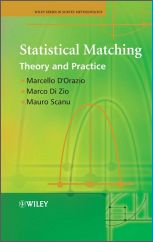Details

|
D'Orazio, Marcello; Di Zio, Marco; Scanu, Mauro: Statistical Matching Theory and Practice Preis: € 83,90 Reihe: Wiley Series in Survey Methodology, Einband: Gb Auflage: 1. Auflage Verlag: John Wiley & Sons Erscheinungsdatum: 03/2006 Seiten: 268 S. ISBN-10: 0-470-02353-8 ISBN-13: 978-0-470-02353-2 
|
||||||
|
Weitere Fachbücher aus dem Fachgebiet: Datenanalyse und Data Mining | Marketing u. Vertrieb | Methoden zur Daten-/Stichprobenerhebung | Spezialthemen Informatik | Statistik |
|
|||||||
| |||||||




 CRISPR-Cas:
CRISPR-Cas: Budding Yeast
Budding Yeast Learning and Memory
Learning and Memory Conservation Science: Balancing the Needs of People and Nature
Conservation Science: Balancing the Needs of People and Nature Introduction to Optical Microscopy
Introduction to Optical Microscopy Organic Chemistry
Organic Chemistry CURRENT PROTOCOLS Wiley USA
CURRENT PROTOCOLS Wiley USA